|
Champagne Shades
by Liz
Nutter
©
Copyright 1999, Voice of the Tennessee Walking Horse, Lewisburg,
Tennessee
Reprinted with permission from Liz
Nutter
So, you think you
have a palomino, or maybe you were lucky enough to find a
buckskin. Have you looked under your horse's tail to be sure?
No, this isn't a
bawdy joke. Truth is, not all golden horses are what they seem.
According to the latest research by two of the country's leading
equine color geneticists, many "palominos" and "buckskins" are
actually the creation of a newly documented gene the champagne
gene.
I repeat, newly
documented. That doesn't mean the gene itself is new. In fact,
there's strong evidence to believe champagnes have helped "color"
our breed since the very foundation of our industry yes, since old
Golden Sunshine F-44 himself.
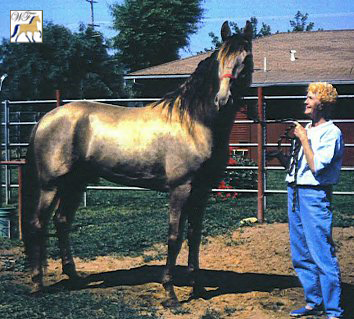 But,
more about the history later. First, exactly what color is
champagne? As it turns out, it's a lot of colors. But,
more about the history later. First, exactly what color is
champagne? As it turns out, it's a lot of colors.
Walking horse
enthusiasts who have heard of "champagne" most likely think of the
unusual weimeraner-tan shade of the old show mare Champagne Lady
Diane and her descendants, including the mare's only surviving
son, Champagne Look, owned by Bea Kinkade in California (her first
champagne son, Champagne Night, owned by Wiley Bailey in Arkansas,
died last summer). Kinkade, with the help and support of
geneticist Dr. Ann Bowling at the University of California at
Davis, has almost single-handedly educated the walking horse world
on that particular shade of champagne. In fact, it was Kinkade who
convinced the Tennessee Walking Horse Breeders' and Exhibitors'
Association to include the champagne color option on registration
forms.
Phil Sponenberg,
DVM, PhD. at Virginia Tech has also studied the champagne gene for
many years, since one of his own horses, a Spanish Mustang mare,
was champagne. By tracking down dozens of champagnes and their
offspring around the country, Dr. Sponenberg discovered that the
champagne gene creates a wide range of colors beyond the classic
weimeraner-tan, including a palette of golds, yellows and ambers.
Sponenberg explains,
"The champagne gene is what we call a 'dilution gene.' That means
it dilutes any horse's base color whether that's black, bay or
chestnut much like the cremello gene does to create palominos and
buckskins."
According to Sponenberg, the champagne gene
dilutes red tones (chestnut and sorrel) to gold or yellow, while
it turns black tones to brown or tan. For instance, a horse that
would have otherwise been black is diluted to the classic
champagne color a brownish-tan or taupe with chocolate brown
points (legs, mane and tail). On a bay, the red body is diluted to
gold, and the points are diluted to brown, resulting in what some
champagne breeders are calling an "amber" champagne a horse that
looks similar to a buckskin, except the points are brown instead
of black. On a chestnut or sorrel, all the red is diluted to gold,
with either a gold or flaxen mane and tail, which results in a
"gold" champagne often a palomino look-alike.
Despite similarities
with palominos and buckskins, it is easy to separate the
champagnes from the others, Sponenberg says. "Look at the skin.
True palominos and buckskins have the same dark gray/black skin
that chestnuts, bays and blacks have," he points out. "Champagnes,
on the other hand, have pale skin pink, whitish or sometimes
golden which is usually speckled or mottled with dark freckles.
Old-timers often called it pumpkin-skinned."
Which brings us back
to the "have you looked under the tail?" question. Because the
freckles or mottling can be heavy around the muzzle and eyes, even
to the point of making the skin look dark, the best place to check
for skin color is under the tail or between the back legs, in the
udder or sheath area.
Champagne foals of
all shades are usually born with bright blue eyes which change to
a golden amber or hazel, usually by the time the foal is a year
old. If it weren't for those blue eyes and pink skin, champagne
babies would often be difficult to identify since they can be much
darker at birth than they are after their first shedding. Many
"gold" champagnes are born bright chestnut, with red manes and
tails; some "amber" champagnes are born bay.
Another key
characteristic of champagnes is that their fur tends to be
exceptionally shiny, with an almost metallic or iridescent sheen.
They can look somewhat dull in the shade, but out in the sun, they
practically glow. Many people have commented on how champagnes
seem to "change colors" in different lights.
Champagnes, like
palominos and buckskins, are sometimes dappled. On the classic and
amber shades, the dappling is usually darker than the body color.
On the gold shades, the dapples can be light or dark. Sometimes,
dappling is noticeable only in winter. Also, unlike most palominos
and buckskins, who tend to get paler in the winter, champagnes are
usually darker in winter.
In the past,
geneticists haven't been quite sure how to classify these colors.
The amber champagnes were just called buckskins; the classic
champagnes were usually lumped in with duns, often called lilac
duns; and most geneticists just put the gold champagnes over with
the palominos, calling them "pink-skinned palominos." (Note: the
Palomino Horse Association has always registered all "palominos"
regardless of skin color. In 1943, however, the larger palomino
organization, the Palomino Horse Breeders of America, stopped
accepting the light-skinned ones, which possibly helps explain why
so few champagnes exist today.)
So, although the
basic champagne shades (classic, amber and gold) are not new, the
discovery that they are related and created by the same gene is
very new. Which is why there are still a few unanswered questions.
For instance, the Sponenberg/Bowling research indicates that the
gene is a dominant one. That means there is a 50% chance of
getting a champagne foal any time you breed a champagne to a
non-champagne (it also means that if your foal isn't a champagne
color, it doesn't carry the gene recessively). What is not known,
however, is whether the champagne gene in homozygous form (a
double dose, so to speak) is like the cremello gene, doubling the
dilution effect to create an almost-white horse with blue eyes and
freckles, or whether it is more like the dun gene, which looks no
different in double doses than in single doses (a homozygous dun
looks just like a heterozygous dun).
Several offspring
from gold-champagne-to-gold-champagne crosses have been found, and
they all look like their parents, gold with pale manes and tails.
However, as with any dominant gene, there is only a 25% chance of
getting a homozygous with any heterozygous-to-heterozygous cross,
so maybe we just haven't found that elusive double-dilute yet.
On the other hand,
the champagne gene does appear to have an "additive" effect when
combined with the cremello gene. In three documented instances, a
gold champagne TWH stallion crossed with a palomino TWH mare
created an "ivory champagne," a cream-colored horse with light
eyes (blue or greenish-amber) and mottled pink skin. It is
believed that an ivory champagne crossed with, say, a chestnut has
an equal chance (25%) of producing a chestnut, a gold champagne, a
dark-skinned palomino, or another ivory champagne.
The creation of the
three ivory champagnes above does not mean that whenever a gold
champagne is crossed with a palomino the result is a
double-diluted ivory champagne. That only happens 25% of the time.
The other odds are, again, 25% chestnut, 25% gold champagne and
25% dark-skinned palomino. Carol Babbs in Illinois, for instance,
has a palomino mare who, when bred to a gold champagne stallion,
produced a dark-skinned palomino filly one year and then a
pink-skinned gold champagne filly the next year.
...Okay, okay.
Enough of the genetic technobabble. Let's get to the really
intriguing stuff. Where did today's champagne TWHs come from?
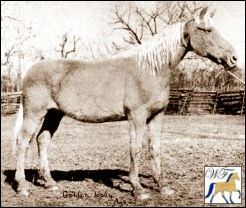 My theory is that some of our very first yellow
horses were champagnes. In fact and I can hear the pshaws of
disbelief already I believe old
Golden Lady #350031
(PICTURED LEFT AT AGE 33), foaled in
1913, and her three golden foals (Golden Sunshine F-44, Golden
Girl #350019, and
Yellow Jacket #360141) as well as many of her
grand-get, including
Barker's Moonbeam #380497, were actually
champagnes. My theory is that some of our very first yellow
horses were champagnes. In fact and I can hear the pshaws of
disbelief already I believe old
Golden Lady #350031
(PICTURED LEFT AT AGE 33), foaled in
1913, and her three golden foals (Golden Sunshine F-44, Golden
Girl #350019, and
Yellow Jacket #360141) as well as many of her
grand-get, including
Barker's Moonbeam #380497, were actually
champagnes.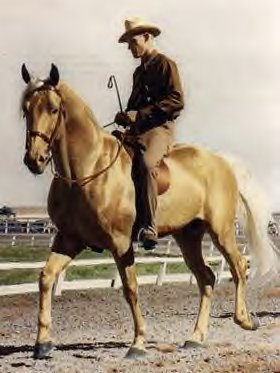
Golden Lady was owned throughout her breeding
career by Burt Hunter of Lewisburg, Tennessee. Burt's daughter,
Jean Hunter, remembers well her family's golden horses and
described
Golden Sunshine F-44 to me in vivid detail. "He was the
most unusual color you've ever seen," she says. "You could put a
gold dollar up against him and stand back in the sun, and you
couldn't see the dollar. And he had white skin and yellow eyes.
His mother, Golden Lady, was the same way." Golden Girl and
Yellow
Jacket(PICTURED
RIGHT) had the same pale skin and eyes, Jean added.
So, what about
Golden Sunshine's most famous son,
Barker's Moonbeam, who in 1948 was called "the foundation sire of
the Palomino Walking Horse" by Dr. H. Arthur Zappe, secretary of
the Palomino Horse Breeders of America?
Well, McAllen
Finley of Readyville, Tennessee, says, "I can remember my
grandfather saying that
Barker's Moonbeam was sort of a dun color,
yellow with a brownish mane and tail. And he had pink skin. He was
not a palomino." Finley's grandfather was none other than Vance
Paschal, noted palomino breeder and the nephew of C. O. Barker,
who owned Barker's Moonbeam.
Ray Barker, C. O.'s son, confirms the
yellow-with-brown-points description, "to the best of [his]
memory." Even more telling,
Barker's Moonbeam was registered
simply as "yellow horse." Period. No "white mane and tail," as
most palominos were registered back then.
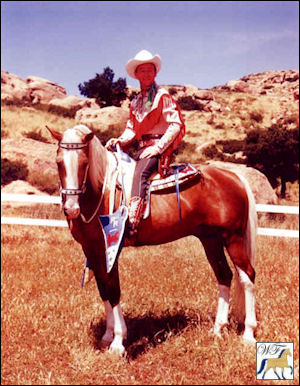 Certainly, there are many famous yellow sons of
Barker's Moonbeam who were dark-skinned palominos, including our
breed's most famous palomino,
Allen's Gold Zephyr #431975, a.k.a.
Roy Rogers' Trigger, Jr. [pictured
left] But, there are at least two ways this
could have happened. Certainly, there are many famous yellow sons of
Barker's Moonbeam who were dark-skinned palominos, including our
breed's most famous palomino,
Allen's Gold Zephyr #431975, a.k.a.
Roy Rogers' Trigger, Jr. [pictured
left] But, there are at least two ways this
could have happened.
First, breeding gold to gold was a common practice
in the 1930s and 1940s, and some of the dark-skinned sons and
daughters of
Barker's Moonbeam most likely had dark-skinned
palomino or buckskin dams. It could also be that
Barker's Moonbeam
was an amber champagne with an added cream gene (the color of
his dam is unknown she may have been a palomino or buckskin, for
all we know). If he did carry two different dilution genes,
Barker's Moonbeam could have produced both pink-skinned champagnes
and dark-skinned palominos/buckskins (which would help explain his
extremely high color-production percentage).
Unfortunately, good-quality photographs from the
1930s and 1940s are very difficult to find. Almost none show faces
in enough detail to determine skin color (and I've yet to find an
under-the-tail shot!).
However, there's no doubt in my mind that many of
our industry's first yellow horses were pink-skinned champagnes.
Too many of our champagnes today trace directly to
Golden Lady for
the case to be otherwise.
Take, for example, the champagnes produced over
the past 20-plus years by Belle Zyla in Beloit, Wisconsin. Back in
the early 1970s, Belle bought a pink-skinned cream-yellow mare
named Yellow Lady M. #667022, sired by Yellow Jacket's Ace #482625
(golden, with a white mane and tail), who was a direct son of
Yellow Jacket #360141 (a son of old
Golden Lady). There is no other line of yellow
or gold in Yellow Lady M.'s papers, so her champagne gene must
have been passed down from
Golden Lady. With Yellow Lady M. as her
foundation, Belle Zyla has raised four additional generations of
champagnes of all shades classic, amber, gold and ivory (although
they were registered, for lack of alternatives, as duns,
buckskins, palominos and cremellos).
 In
Helena, Montana, Gay Wagner has nurtured another line of
champagnes which trace, in one single line of color, directly to
Golden Lady. Gay's first classic
champagne mare was Jester's Fanfare #741782, out of a yellow mare
named R.J.'s Lady Sunset #682192, who was out of Miracles Golden
Lady #601714, who was a daughter of Buck LaMarr #450574, whose
sire was Flash LaMarr #411549 (registered as yellow with a flax
mane and tail), who in turn was sired by
Yellow Jacket #360141,
son of
Golden Lady. Whew! Today, Gay still owns a daughter and a
granddaughter of her old mare, and both are classic tan-with-brown
champagnes. In
Helena, Montana, Gay Wagner has nurtured another line of
champagnes which trace, in one single line of color, directly to
Golden Lady. Gay's first classic
champagne mare was Jester's Fanfare #741782, out of a yellow mare
named R.J.'s Lady Sunset #682192, who was out of Miracles Golden
Lady #601714, who was a daughter of Buck LaMarr #450574, whose
sire was Flash LaMarr #411549 (registered as yellow with a flax
mane and tail), who in turn was sired by
Yellow Jacket #360141,
son of
Golden Lady. Whew! Today, Gay still owns a daughter and a
granddaughter of her old mare, and both are classic tan-with-brown
champagnes.
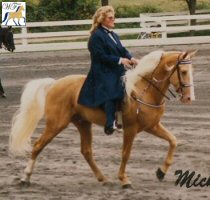 One
of the best known gold champagne stallions on the east coast is
Sir Joseph's Rocker #833066, a long-striding plantation show horse
owned by Curtis and Kathy Tibbs of Kearneysville, West Virginia.
Although bred sparingly, Rocky has sired well over a dozen gold
champagne foals. One
of the best known gold champagne stallions on the east coast is
Sir Joseph's Rocker #833066, a long-striding plantation show horse
owned by Curtis and Kathy Tibbs of Kearneysville, West Virginia.
Although bred sparingly, Rocky has sired well over a dozen gold
champagne foals.
Rocky's dam, Flame's Gold Honey #782972, was sired
by Wilson's Gold Flame #691191, sired by Wilson's Band O Gold
#591699, sired by Wilson Strollin Gold #540189. But here's where
things get tricky. Strollin Gold was by a son of Allen's Red Eagle
#390381, whose mamma was the buckskin mare
Hendrixson Bonnie
#410642 (the grand-dam of the dark-skinned palomino stallion
John A.'s Chance #491026, which means that
Allen's Red Eagle was also probably dark-skinned). But Strollin
Gold's dam was Kate Vaught #444177, a yellow mare by, aha!,
Barker's Moonbeam, grandson of
Golden Lady.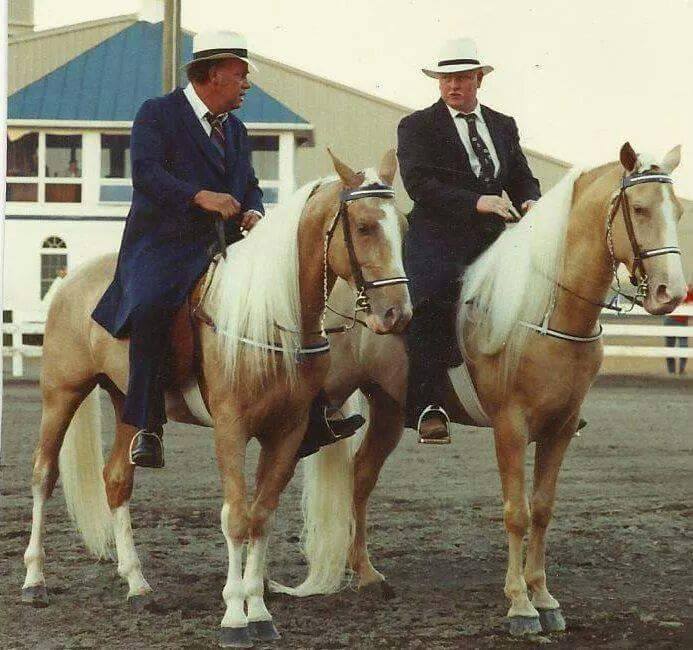
Kathy Tibb's sister, Vicki Danmeyer, owns a
classic champagne mare named Flame's Ebony Rose #920378, sired by
Boyd's Gold Flame #853596, sired by Wilson's Gold Flame. Since the
Tibbs' stallion and Vicki's mare are both Wilson's Gold Flame
grand-get, odds are that he, Wilson's Band O Gold, and probably
Wilson's Strollin Gold, were all pink-skinned gold champagnes.
Unfortunately, one of the biggest problems in
tracing the color on champagnes is that, until recently, no one
knew what to call them. In the past, the various shades have been
registered as yellow, palomino, buckskin, dun, brown, even
chestnut or bay. Many were also roan, and back in the 1930s and
1940s, a horse that might have been a "yellow" roan was more than
likely registered as simply "roan." So, it's not unusual for the
champagne line of color to just "disappear" in a pedigree.
Champagne
Lady Diane #696266 herself, registered as a chestnut, is a prime
example. Although her dam, Mack's Golden Girl H. #650174, was
registered as yellow with a flax mane and tail, the line of
"color" stops there. Both parents of Mack's Golden Girl H. were
registered as sorrel, and the four grandparents were registered as
chestnut, sorrel, white (by Merry Boy, a roan), and roan. (Note:
After having tracked down dozens of gold champagnes a few of which
are practically orange I can easily understand how some of the old
gold champagnes were misregistered. Some of the ones I've seen
would not have qualified as "yellow," and there were no other
options other than sorrel.)
Another well known line of
champagne walking horses is the Arian line, started by Linda
Howland of Kempton, Pennsylvania. Howland's champagnes also began
with a mare, Argot's Merry Rena #705779 ("Maggie"), who is gold
with a white mane and tail. Her dam, Merry Go Boy's Rena #665603,
was also gold, sired by Merry Go Boy's Son #571362, who was
registered as brown. Maggie, when bred to Howland's black stallion
(Arian Jazz Man), produced three champagnes, including an amber
champagne stallion, Arian's Golden Sun #830478, now owned by Midge
McGoldrick of Anza, California. Golden Sun's champagne sons
include Fingall MacCailleach #896664, Arian Gold Perfect'n
#888755, and Arian Golden Prince #906562.
Imagine McGoldrick's shock last summer when Dr.
Sponenberg told her not only that Arian's Golden Sun, her
"buckskin" stallion, was actually an amber champagne, but also
that her "palomino" stallion was a gold champagne, AND that her
"cremello" stallion was an ivory champagne. Talk about changing
colors!
But McGoldrick was delighted. In addition to
Arian's Golden Sun, she stands at stud her show-ring champion,
Ebony's Rocky Boy #857437 (her gold champagne), and his son,
Windcrest's High Voltage #901649 (her ivory champagne). Rocky is a
Tennessee-born-and-bred stallion whose great-great-granddam (Betsy
Jones #452538) was a daughter of
Barker's Moonbeam.
Other gold champagne stallions leaving their
colorful mark on our breed include Brooke's Class Act #847431,
owned by Goldman Cherry in Olmstead, Kentucky; Big Yellow Chief
#736141, owned by Vance King in Rockvale, Tennessee; and Mr.
Yellow Gold Dust #902458, owned by Odean and Loreen Harp in
Lafayette, TN.
One of the most intriguing champagne stallions is
Go Boy's Gold Insignia #882036, who is a deep amber champagne
(almost a copper-gold, with a dark chocolate mane and tail). It
appears that he is also a homozygous tobiano, with 100% spotted
foals, about half of which are also champagnes. Owned until
recently by Mike and Tommie Spurlock in Shelbyville (who now have
a solid, classic champagne stallion out of an Insignia daughter),
Insignia is now the property of Charles R. Short in Bloomington,
Indiana.
No doubt, the many beautiful shades of champagne
will become increasingly popular in Tennessee Walking Horse
circles as more breeders learn how to produce them. As an avid
student of old "yellow" bloodlines, I plan to continue trying to
identify which of our old horses were dark-skinned palominos and
which were pink-skinned champagnes. If you'd like to share your
pedigrees, photographs, ideas and opinions (even those which
strongly disagree with my own!), please write to Liz Nutter, 1615
Palmer Road, Lebanon, TN 37090.
|